Abstract
The Middle Jurassic Tuttle Lake Formation in the northern Sierra Nevada, California, comprises a thick volcaniclastic sequence deposited in a submarine island-arc setting and penetrated by numerous related hypabyssal intrusions. A composite andesite-diorite intrusive complex ≥4.5 km long and ≥1.5 km thick was emplaced while the host Tuttle Lake sediments were still wet and unconsolidated. Large parts of the intrusive complex consist of peperite formed where andesitic magma intruded and intermixed with tuff, lapilli-tuff and tuff-breccia. The southern half of the complex consists of augite-phyric andesite containing peperite in numerous small, isolated pockets and in more extensive, laterally continuous zones. The peperites comprise three main types recognized previously in other peperite studies. Fluidal peperite consists of small (≤30 cm), closely spaced, at least partly interconnected, globular to amoeboid andesite bodies enclosed by tuff. This peperite type developed during intrusion of magma into fine-grained wet sediment along unstable interfaces, and fluidization of the sediment facilitated development of complex intrusive geometries. Blocky peperite and mixed blocky and fluidal peperite formed where magma intruded coarser sediment and underwent variable degrees of brittle fragmentation by quenching and dynamic stressing of rigid margins, possibly aided by small steam explosions. The northern half of the intrusive complex consists predominantly of a different type of peperite, in which decimetre-scale plagioclase-phyric andesite clasts with ellipsoidal, elongate, or angular, polyhedral shapes are closely packed to widely dispersed within disrupted host sediment. Textural features suggest the andesite clasts were derived from conduits through which magma was flowing, and preserved remnants of the conduits are represented by elongate, sinuous bodies up to 30 m or more in length. Disruption and dispersal of the andesite clasts are inferred to have occurred at least partly by steam explosions that ripped apart a network of interconnected feeder conduits penetrating the host sediments. Closely packed peperite is present adjacent to mappable intrusions of coherent andesite, and along the margin of a large mass of coarse-grained diorite. These coherent intrusions are considered to be major feeders for this part of the complex. Examples of magma/wet sediment interaction similar in scale to the extensive peperites described here occur elsewhere in ancient island-arc strata in the northern Sierra Nevada. Based on these and other published examples, large-scale peperites probably are more common than generally realized and are likely to be important in settings where thick sediment sequences accumulate during active volcanism. Careful mapping in well-exposed terrains may be required to recognize large-scale peperite complexes of this type.
Similar content being viewed by others
Author information
Authors and Affiliations
Additional information
Received: 8 June 1998 / Accepted: 4 December 1998
Rights and permissions
About this article
Cite this article
Hanson, R., Hargrove, U. Processes of magma/wet sediment interaction in a large-scale Jurassic andesitic peperite complex, northern Sierra Nevada, California. Bull Volcanol 60, 610–626 (1999). https://doi.org/10.1007/s004450050255
Issue Date:
DOI: https://doi.org/10.1007/s004450050255




